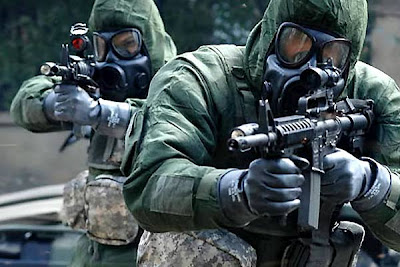CHILDREN OF MEN (2006)
28 WEEKS LATER (2007)
The Americans make London their 51st state, and prove
as dangerous a threat as the ‘infected,’ in 28 WEEKS LATER.
as dangerous a threat as the ‘infected,’ in 28 WEEKS LATER.
IRONICALLY, Danny Boyle’s 28 DAYS LATER – an energetic blend of THREADS and George A. Romero’s THE CRAZIES – actually lead the so-called zombie renaissance even though it’s monsters were living, shrieking, blood-vomiting ‘infected.’ It can be argued that Boyle’s masterwork spawned the wave of undead viscera that shows no sign of abating. From the social breakdown of Romero’s NIGHT OF THE LIVING DEAD, to the political quagmire of Joe Dante’s MASTERS OF HORROR: HOMECOMING, the standard zombie diet has consisted of two delicacies: human meat – preferably intestines – and subtext; you are what you eat, and if you happen to eat people, there is anthropological gristle to chew.
Juan Carlos Fresnadillo’s 28 WEEKS LATER has an American-led NATO force resettling British civilians on an Isle of Dogs safe haven – a metaphor for Baghdad’s Green Zone - after the ‘infected’ from the first film have starved to death. This War on Terror, like its real counterpart, is similarly self-destructive in its bullying authority figures, demoralised combat divisions and fractured family units, a stillborn Iraqesque commentary that sees the Americans smugly declare the war against infection over. But when the situation quickly reaches Code Red they fittingly shoot at will, firebombing city blocks and releasing biological weapons. Here, fear of the ‘infected’ is a horror clearly working closely to the terror of protocol.
This UK preview poster for Fresnadillo’s sequel to 28 DAYS LATER draws heavily from the symbolism of the vastly superior virus movie THE CRAZIES.
28 WEEKS LATER lazily rehashes the first film’s ideas; the only addition to the virus Rage’s cannon is the hint that the ‘infected’ may be undergoing a kind of memory-recall that Romero’s zombies have long since taken for granted. London suggests a decimation of civilisation in general and heroes are hard to find; the two most sympathetic people, Don (a wizened Robert Carlyle) and his naturally immune wife Alice (Catherine McCormack), set the new outbreak in motion in a world of relenting doom. In fact, the film rolls in like a poisonous dust cloud of nihilism. Fresnadillo presents 28 DAYS LATER’s trademark shutter-strobe jump cuts even more frenetically than the original, adding only to the confusion. The director makes the fatal mistake of believing that chaos equals fear, and while he may have been trying to purposely disorient his audience, in reality, all he does is frustrate, equating the whole premise to that of a Rage victim: quick, loud and with little control.
Alfronso Cuaron’s CHILDREN OF MEN is a BLADE RUNNER for the 21st century, telling of a dystopian future where mass infertility has led to a world without children. Unlike Stanley Kramer’s comparable ON THE BEACH – where Australians await killer radiation with good-humoured stoicism – here the Londoners of 2027 respond to the apocalyptic sterility with a howl of self pity, which is embodied in a quasi-fascist democracy of riot shields, caged refugees and feral gangs ("The world has collapsed, only Britain soldiers on.") Beautifully filmed in battle-scarred colour drained hues, the film climaxes in a Hadean vision of Bexhill-on-Sea which most closely resembles war torn Bosnia. In this existence of rubble, Cuaron comments on the problems society faces today: racism, terrorism, government-inspired paranoia and decaying infrastructures.
Theo (Clive Owen) and Kee (Clare-Hope Ashitey) hold the future of humanity literally in their hands in CHILDREN OF MEN. This scene has warring factions stunned into immobility by the sight of a baby.
Non-British filmmakers, who observe the strangeness of this land with the empathy of an outsider’s eye, direct both of these releases; they also add to the grand tradition of British horrors that turn familiar sights into killing fields. Romero’s American Living Dead movies, a quartet of films spanning four decades, saw its zombies become powerful metaphors for racism, consumerism, vivisection and class. Yet there is something particular about phantasms that are placed within familiar British sites, a juxtaposition that has long been exploited by purveyors of the uncanny. Ever since Bram Stoker brought Dracula across the waters from Transylvania to Whitby, and H.G.Wells deposited his extraterrestrial invasion on the outskirts of Woking, these tales seem more credible when played out against the down-to-earth, uptight backdrop of Britain. The United States can use its landmarks to startling effect – one need look no further than the climax to PLANET OF THE APES – but it doesn’t have Britain’s deep, dark ocean of history, and perhaps it is because of this abyss which makes such scenarios resonate more subconsciously.
Layer upon layer of London soil reveals burials from prehistoric and medieval times; the city is one giant grave, from plague pits by The Houses of Parliament to St Paul’s foundations built upon remains of previous eras. One particular location – the brooding labyrinth of the London Underground – has come to embody the morbid groaning of horror’s repressed psyche. DEATH LINE surely inspired John Landis when he let his AN AMERICAN WEREWOLF IN LONDON loose at Tottenham Court Road station. It's here that an unsuspecting passenger is stalked and savaged in a film which trades heavily on the distinction between English locations (Yorkshire pubs, West End porno theatres, Piccadilly Circus, Tower Bridge and London Zoo) and lycanthrope fantasy. More recently, V FOR VENDETTA ran into unexpected controversy when its tube-bound finale chimed too closely with the real-life horrors of the July 7th bombings. Its fitting that the multi-lined network has such appeal; after all, the reason why the tunnel curves between Knightsbridge and South Kensington is because it was impossible to excavate through skeletal catacombs.



